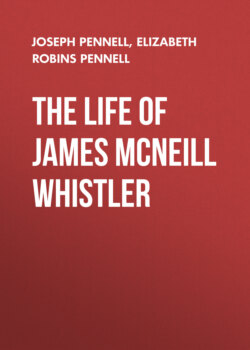Читать книгу The Life of James McNeill Whistler - Joseph Pennell - Страница 26
На сайте Литреса книга снята с продажи.
ROTHERHITHE
ОглавлениеTable of Contents
ETCHING. G. 66
(See page 63)
Those who thought he idled in Paris were as sure of his application in London. "On the Thames he worked tremendously," Armstrong said, "not caring then to have people about or to let anyone see too much of his methods." He stayed for months at Wapping to be near his subjects, though not cutting himself off entirely from his friends. Sir Edward Poynter, Mr. Ionides, M. Legros, Du Maurier visited him. Mr. Ionides recalls long drives down by the Tower and the London Docks to get to the place, as out of the way now as then. He says Whistler lived in a little inn, rather rough, frequented by skippers and bargees, close to Wapping steamboat pier. But there is no doubt that much of his work was done from Cherry Gardens, on the other side of the river. Unfortunately it was not until after his death that we looked into this matter. At any rate, if he lived at Wapping, he worked a great deal at Cherry Gardens, also often from boats and barges, he told us, and this one can see in the prints. Sometimes he would get stranded in the mud, and at others cut off by the tide. "When his friends came," Armstrong wrote us, "they dined at an ordinary there used to be. People who had business at the wharves in the neighbourhood dined there, and Jimmie's descriptions of the company were always humorous." Mr. Ionides drove down once for a dinner-party Whistler gave at his inn:
"The landlord and several bargee guests were invited. Du Maurier was there also, and after dinner we had songs and sentiments. Jimmie proposed the landlord's health; he felt flattered, but we were in fits of laughter. The landlord was very jealous of his wife, who was rather inclined to flirt with Jimmie, and the whole speech was chaff of a soothing kind that he never suspected."
Another and more frequent visitor to Wapping was Serjeant Thomas, one of those patrons who recognise the young artist and appear when recognition is most needed. He bought drawings and prints from Holman Hunt and Legros when they were scarcely known, and he helped Millais through difficult days. Whistler had issued his French Set of etchings in London in 1859: Twelve Etchings from Nature by James Abbott Whistler, London. Published by J. A. Whistler, At No. 62 Sloane Street (Haden's house). The price, as in Paris, for Artist's Proofs on India, two guineas. Serjeant Thomas saw the prints, got to know Whistler, and arranged to publish them, and also the Thames etchings which he sold separately at 39 Old Bond Street, where he had opened a shop with his son, Edmund Thomas, as manager.
Mr. Percy Thomas, a younger son, has told us that, as a little fellow, he often went with his father by boat to Wapping, and that his father and brother posed for two of the figures—the third is Whistler—in The Little Pool, used as an invitation card. He has also told us that much of the printing was done at 39 Old Bond Street, where the family lived in the upper part of the house. A press was in one of the small rooms, and Whistler would come in the evening, when he happened to be in town, to bite and prove his plates. Sometimes he would not get to work until half-past ten or eleven. In those days he put his plate in a deep bath of acid, keeping to the technical methods of the Coast Survey, though it is said that the Coast Survey plates were banked up with wax and the acid poured over them. This is supposed to have been the method of Rembrandt. Serjeant Thomas, in his son's words, was "great for port wine," and he would fill a glass for Whistler, and Whistler would place the glass by the bath, and then work a little on the plate and then stop to sip the port, and he would say, "Excellent! Very good indeed!" and they never knew whether he meant the wine or the work. And the charm of his manner and his courtesy made it delightful to do anything for him. Serjeant Thomas brought Delâtre from Paris, the only man, he thought, who could print Whistler's etchings as the artist would have printed them himself. "Nobody," Ralph Thomas wrote, "has ever printed Mr. Whistler's etchings with success except himself and M. Delâtre," and to-day many people are of the same opinion. Whistler's relations with the firm were pleasant while they lasted. But they did not last long. Edmund Thomas cared less for art than the law, and in the shop he would sit at his desk reading his law books, never looking up nor leaving them, unless someone asked the price of a print or drawing. A successful business is not run on those lines, and in a few years he gave up art for the law, to his great advantage.
